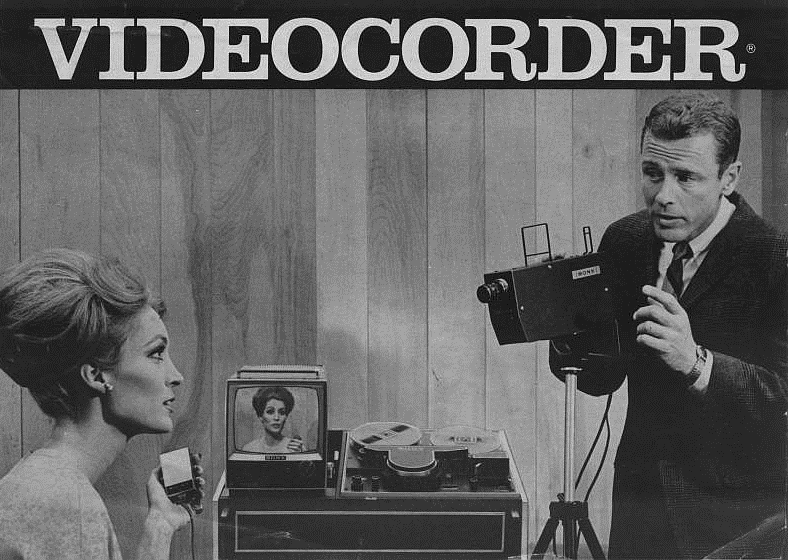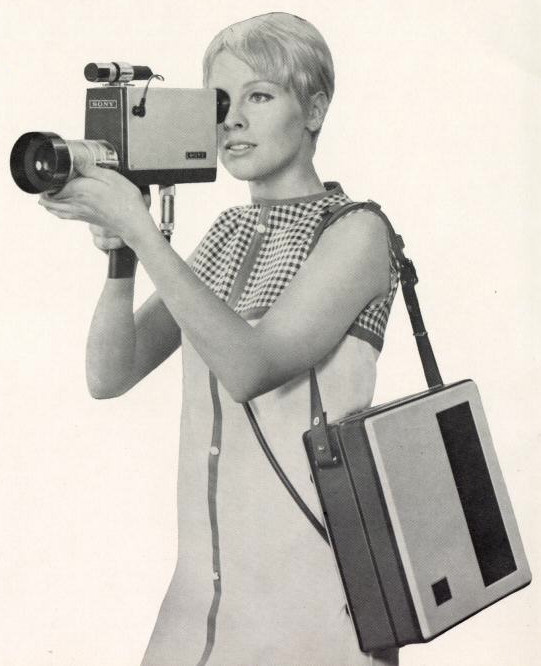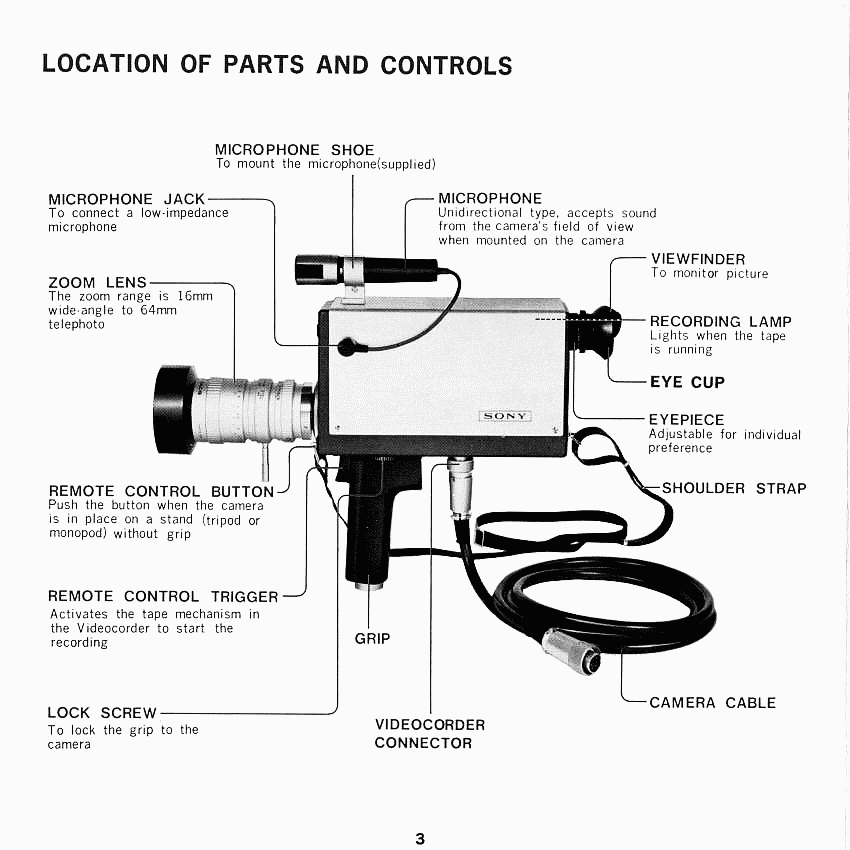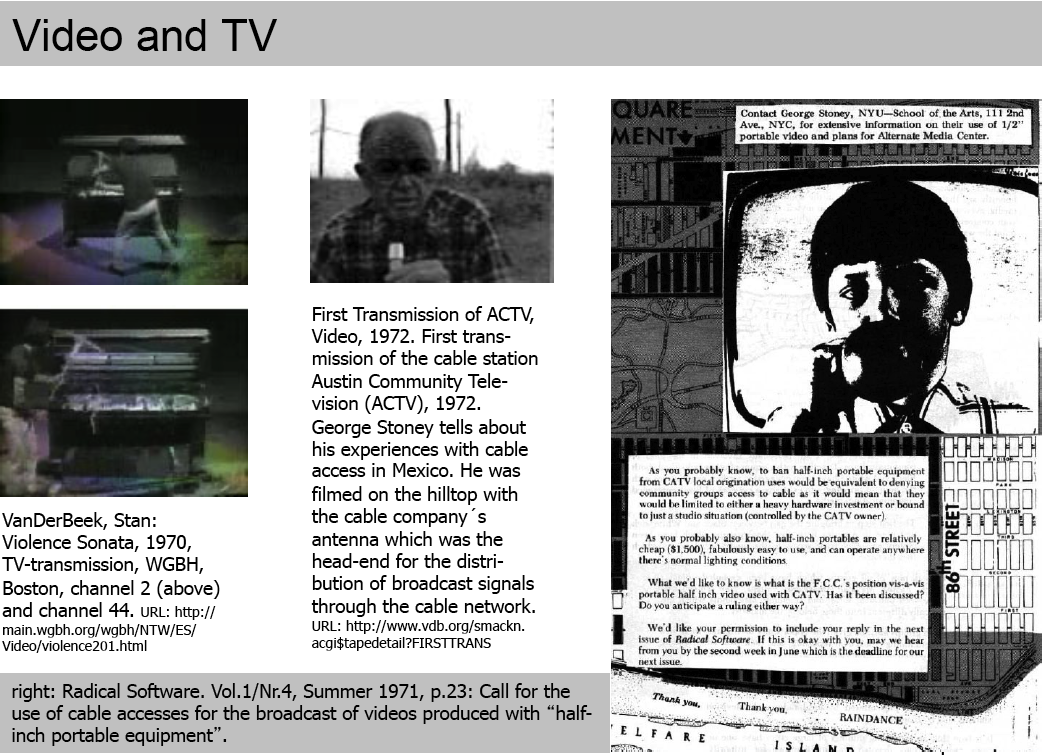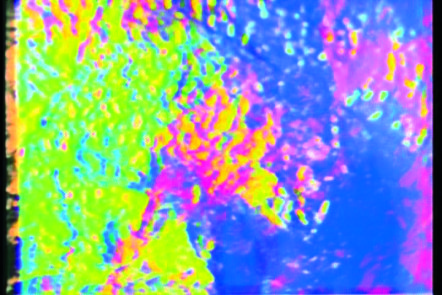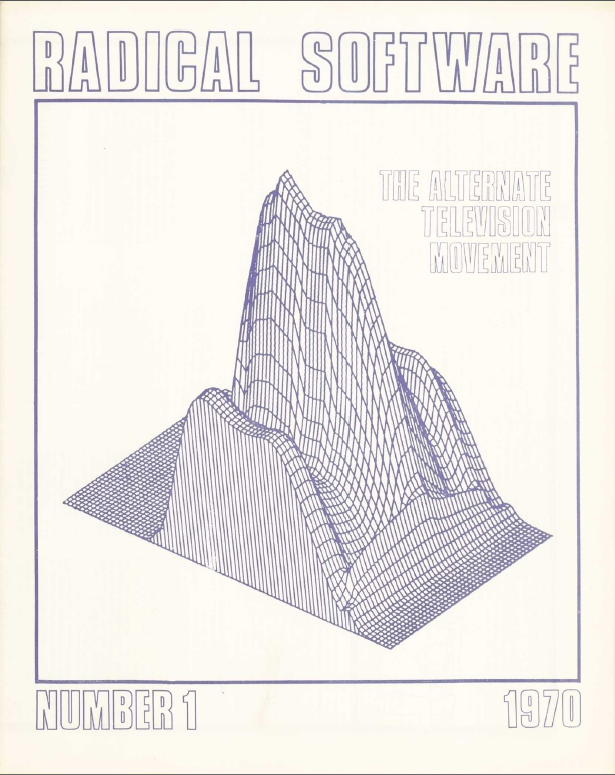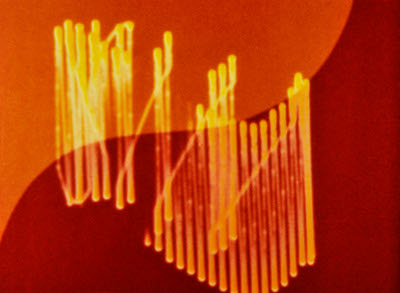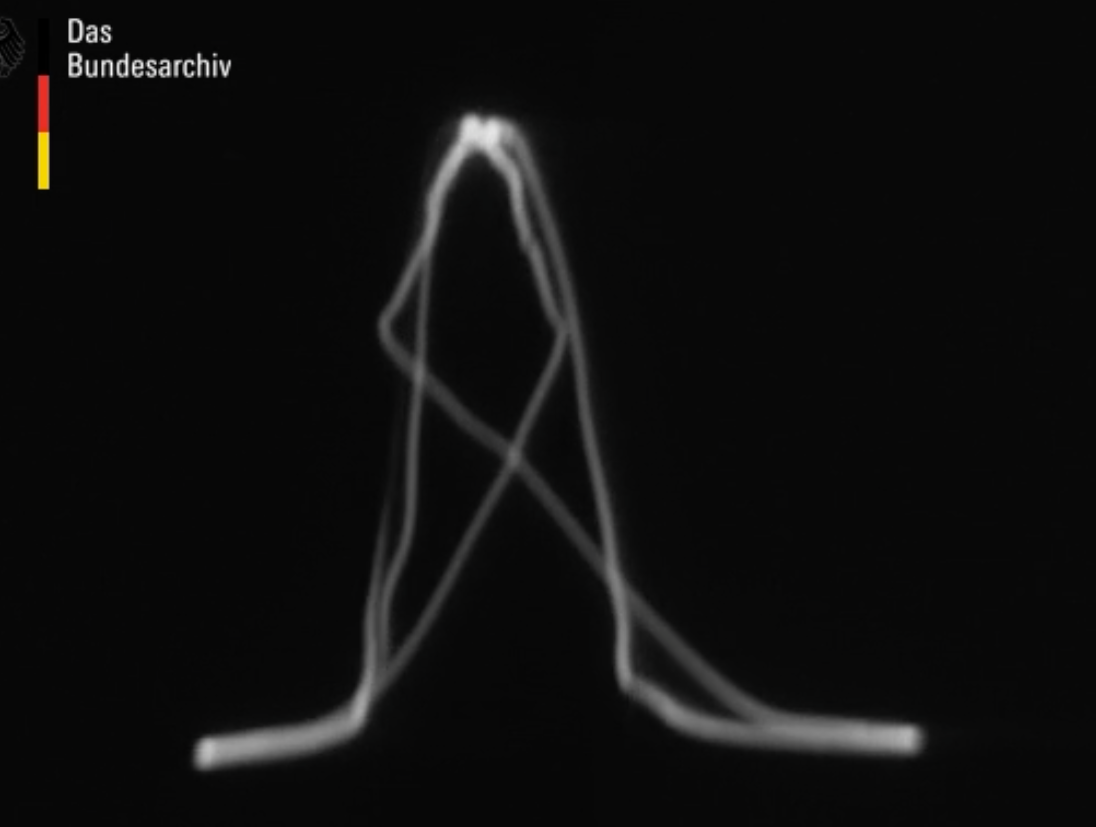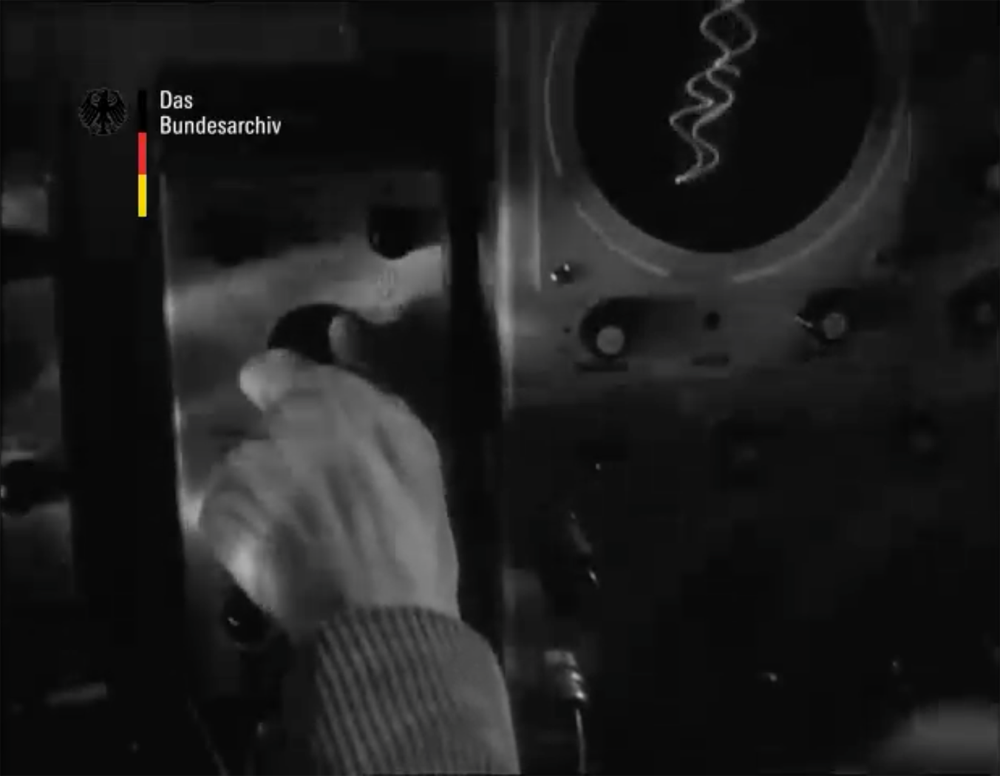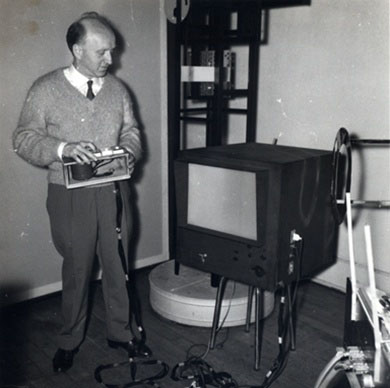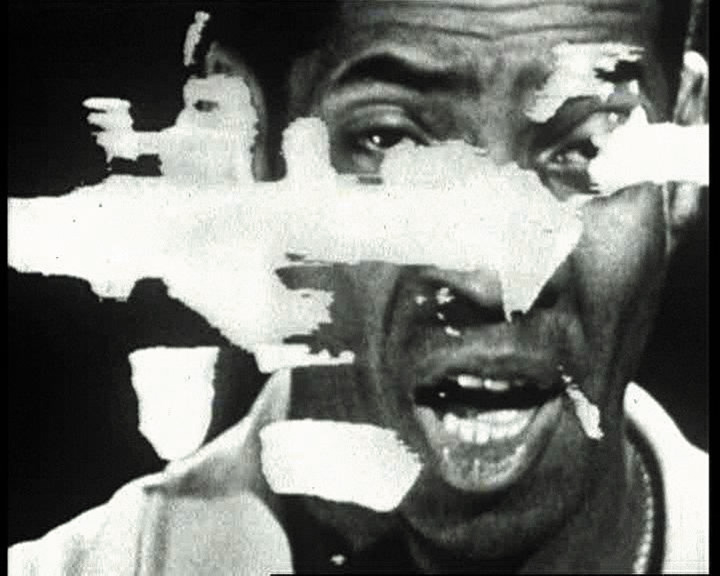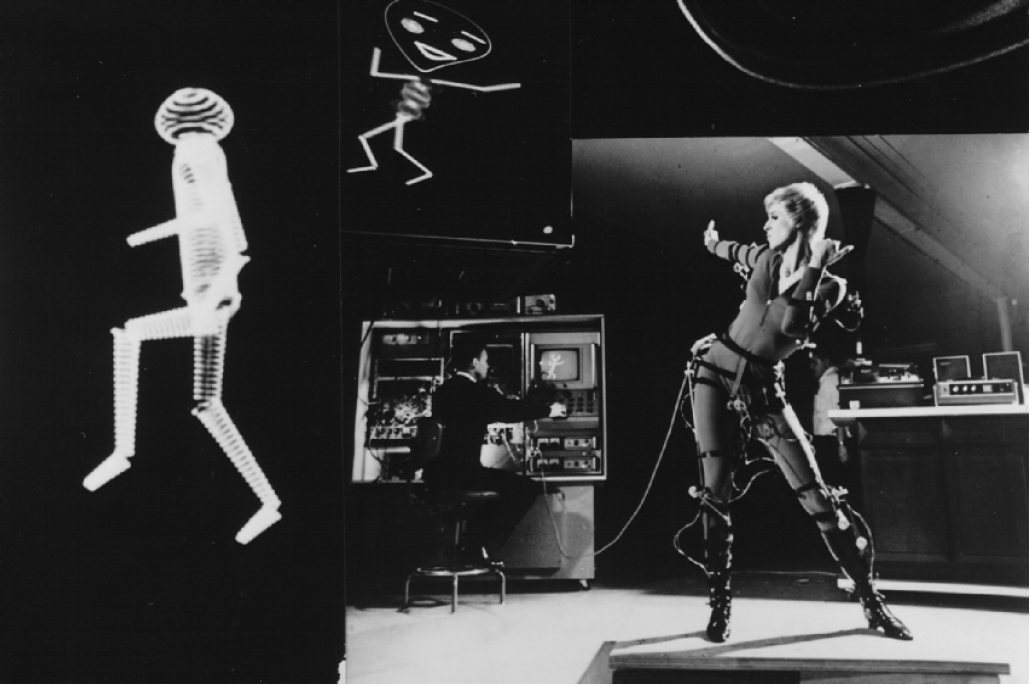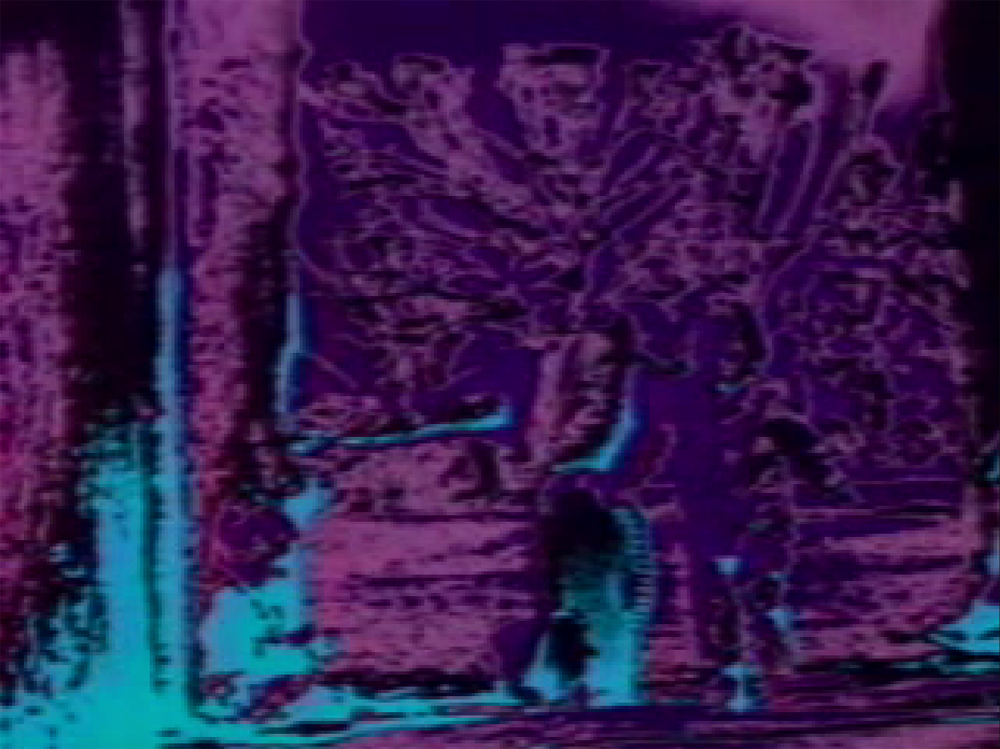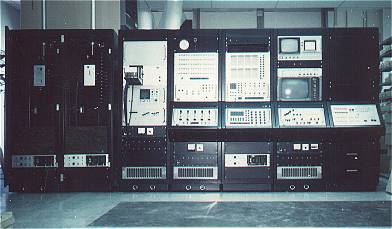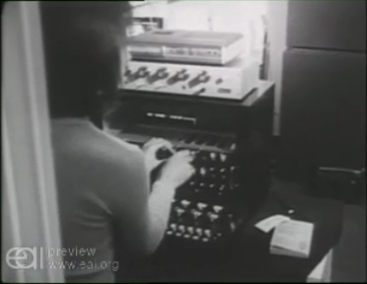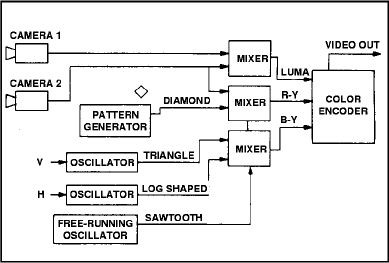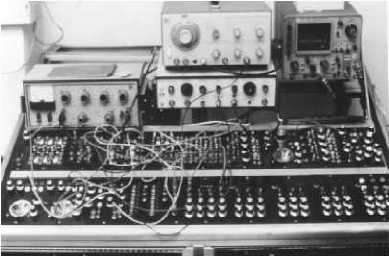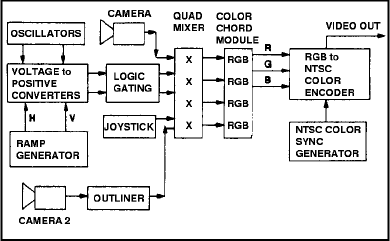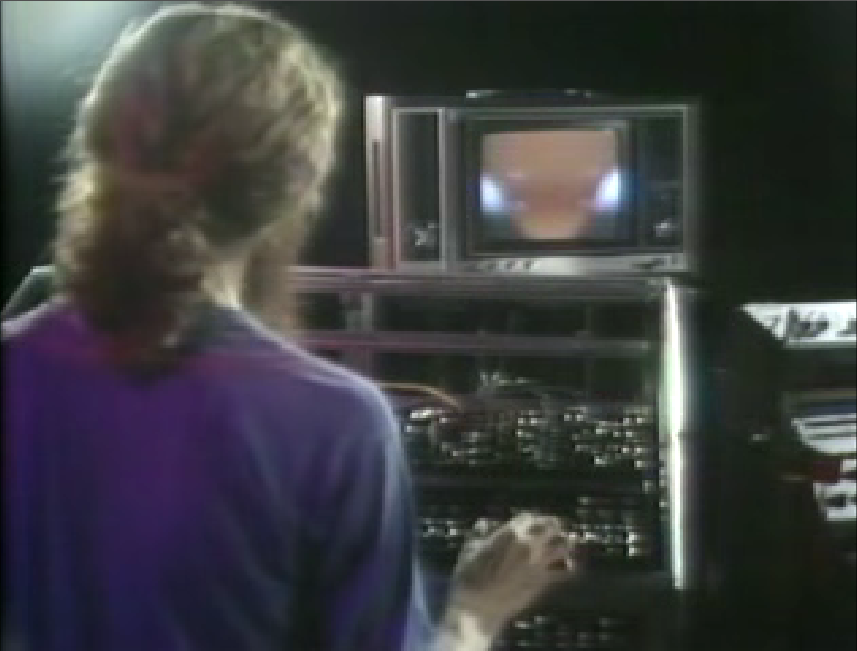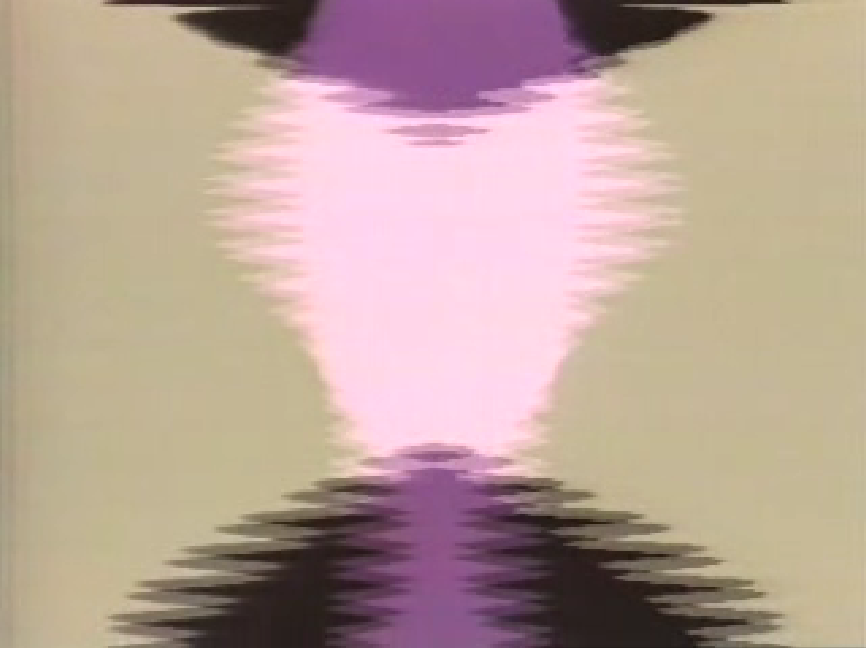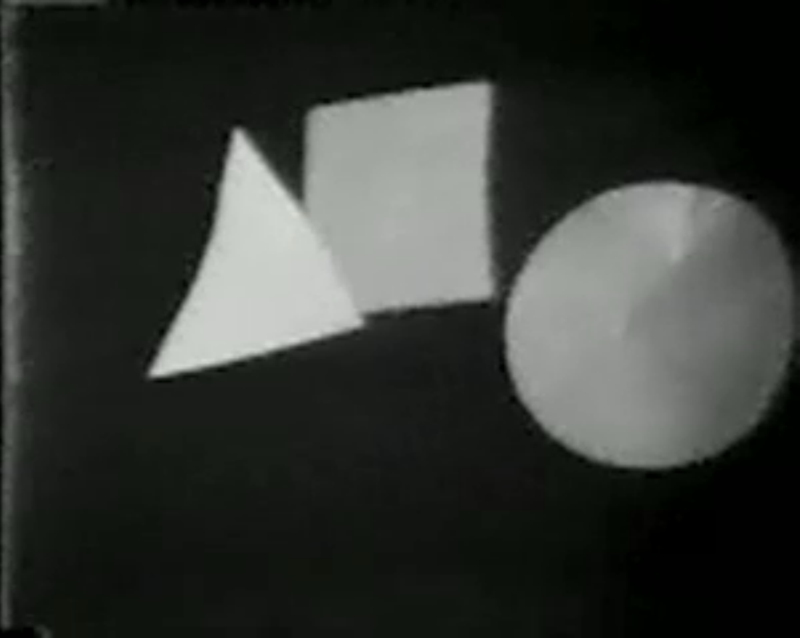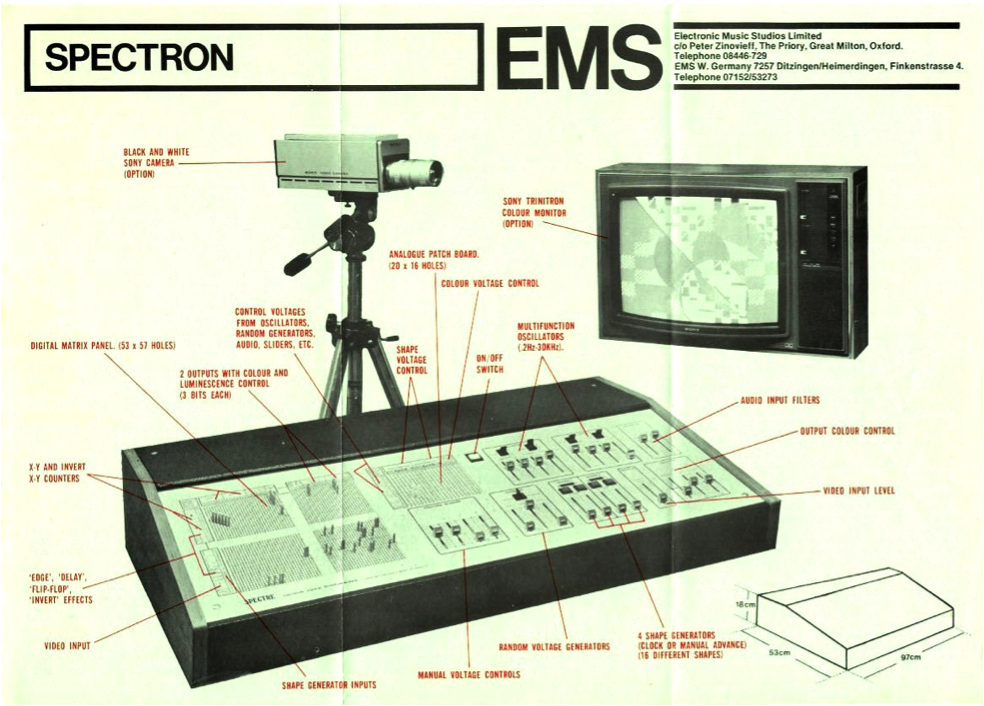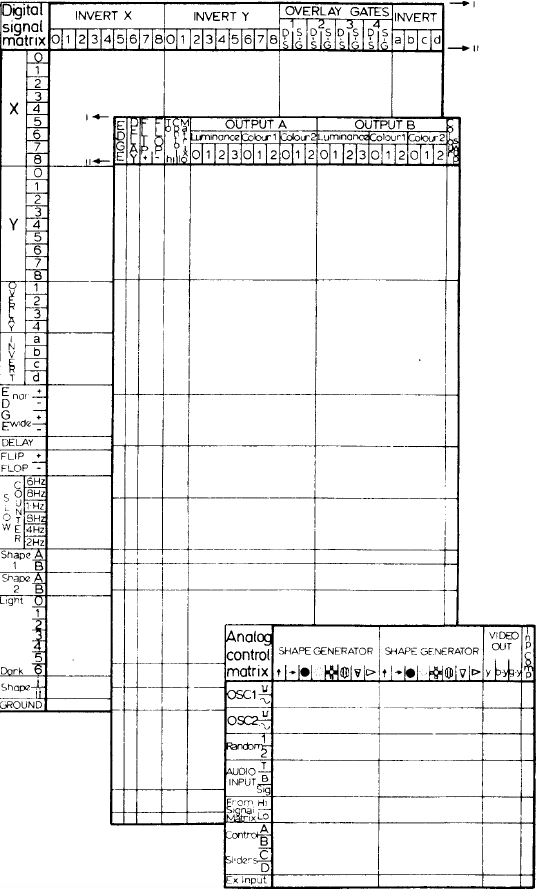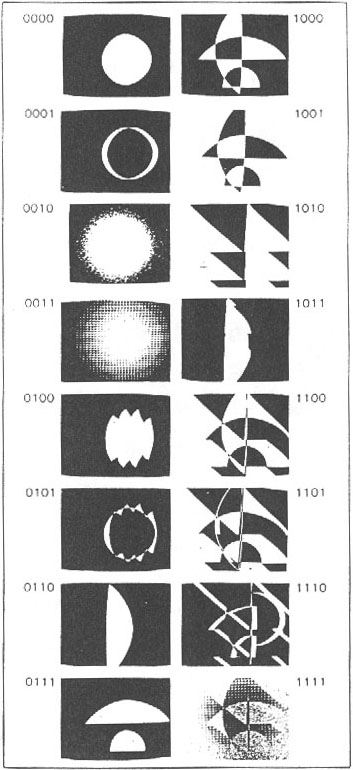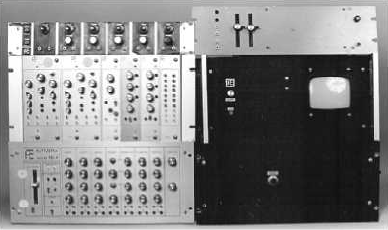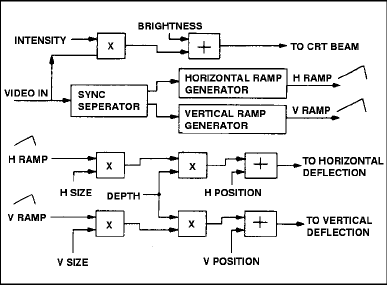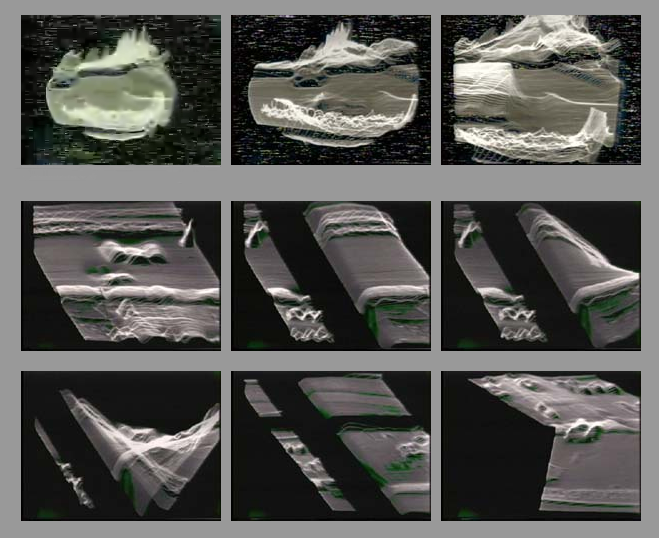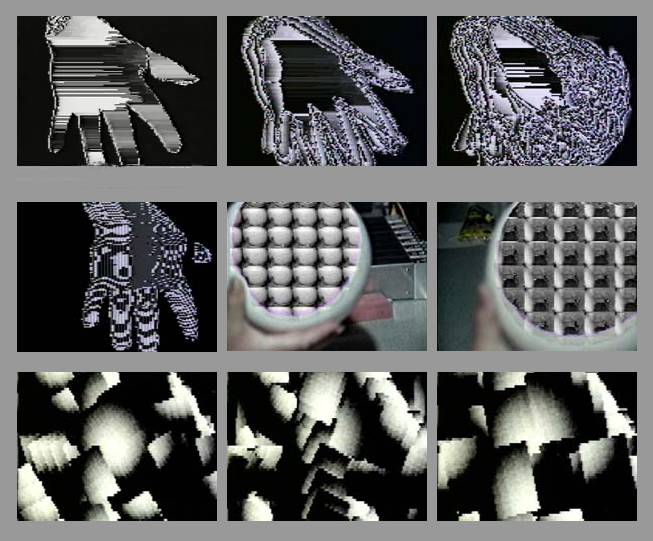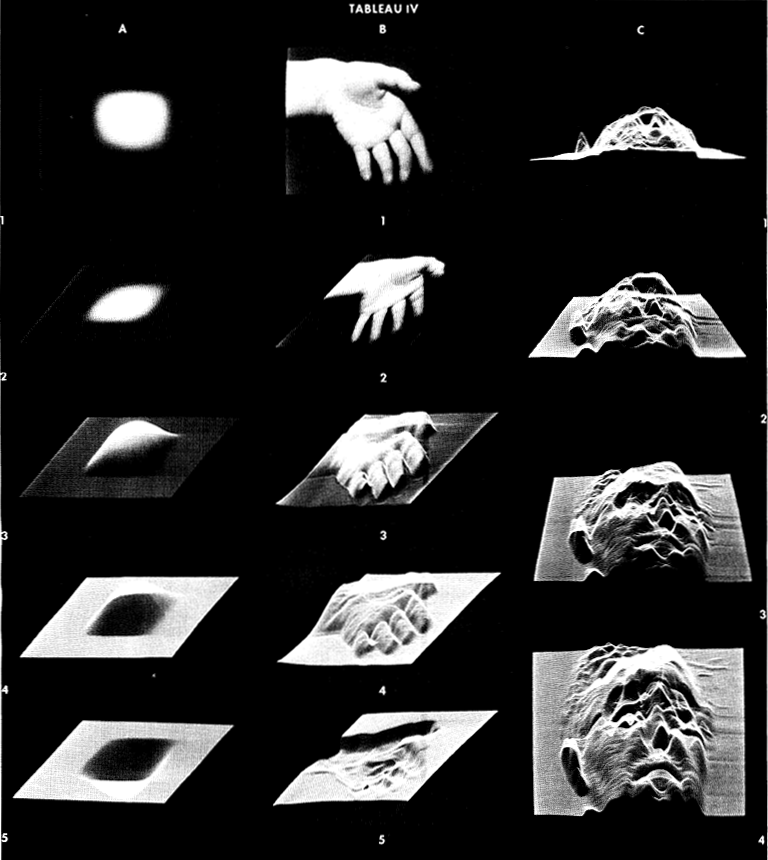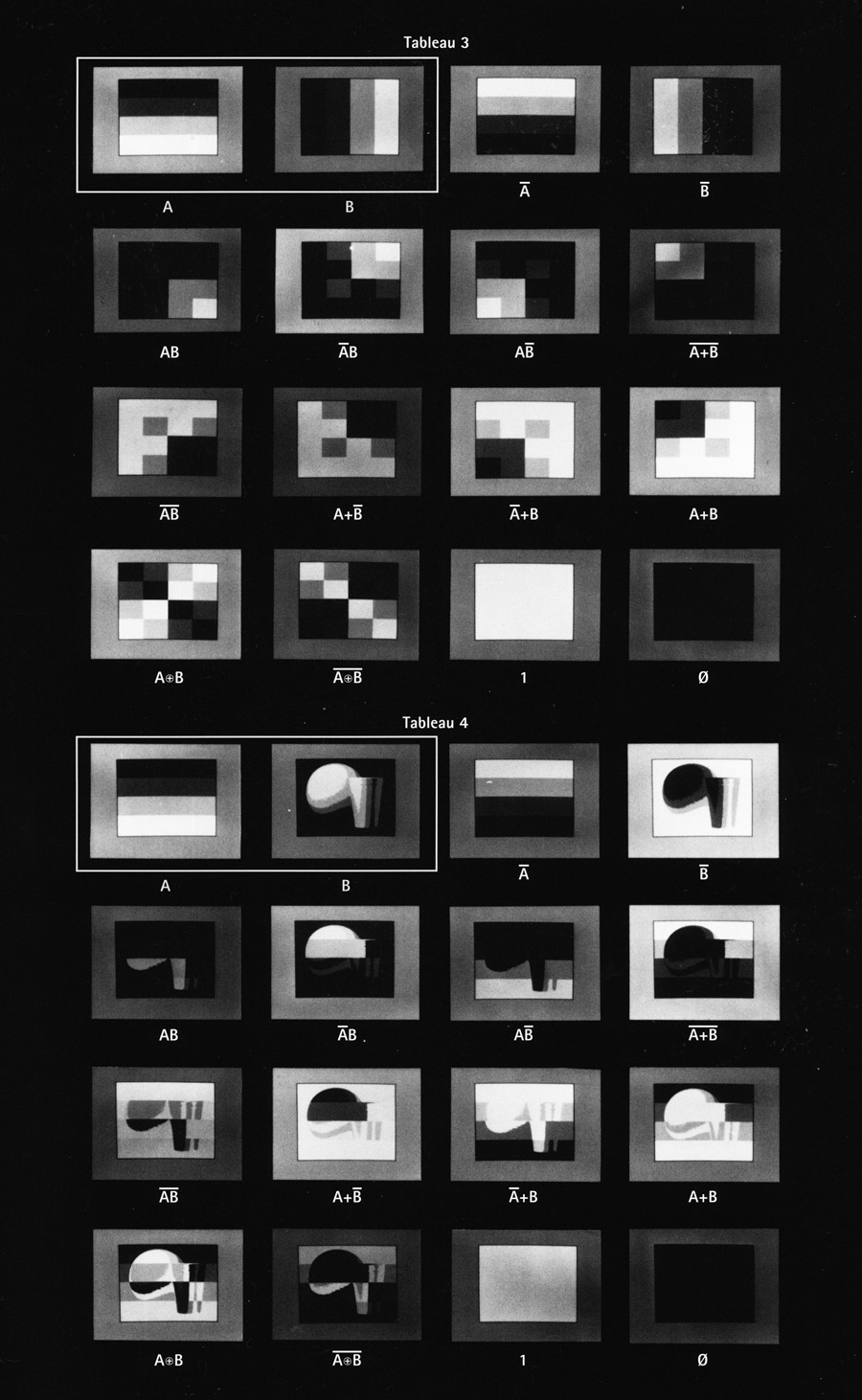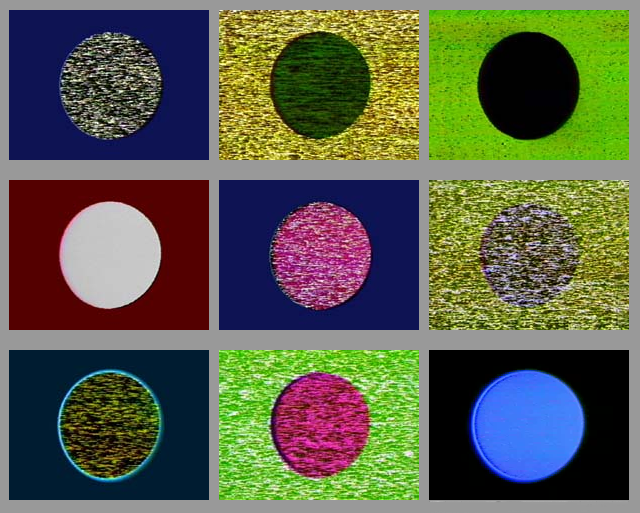IASLonline NetArt: Theory
Thomas Dreher
History of Computer Art
IV. Images in Motion
IV.1 Video Tools
- IV.1.1 Video Cultures
- IV.1.2 Video Synthesizers
- Illustrations Part IV: Video Tools: PPT / PDF
- Table of Contents
- Bibliography
- Previous Chapter
- Next Chapter
Since the mid of the sixties video is an emerging film system usable to produce and to store electronic signals. The mobile elements of the video system are the camera and the recorder meanwhile the player is not moved to the recording location and remains connected with a cathode ray tube (of a TV set). Signals stored on magnetic tapes contain information being sent by players to cathode ray tubes for video presentations.
The sequence of shots (frames) on a film stripe is transformed by a projector into a movie: Meanwhile the film is screened as a moved sequence of images and a light projection, the video system directs electron beams in a vacuum tube. A light emitting video presentation replaces the film projection in a dark room.
The celluloid stripes being editable shot by shot (the frame as a phase image) at cutting tables were substituted by magnetic tapes, video recorders for editing and the `tools´ for `electronic image processing´. The transformations of electronic signals by mixer, sequencer, switcher, keyer and other means replaces film animation techniques developed since the end of the 19th century for the editing of frames and their montage. 1
In the sixties and seventies Stephen Beck, Robert Cahen, Tom DeFanti, Tom DeWitt, Ed Emshwiller, Bill Hearn, Barbara Aronofsky Latham, Phil Morton, Nam June Paik, Eric Siegel, Barbara Sykes, Stan VanDerBeek, Steina und Woody Vasulka, Jim Wiseman and others (see chap. IV.1.2) experimented with processors, synthesizers as well as analogue and digital computers. 2
The signals can be produced with video cameras. They conduct the signals to the storing on magnetic tapes, but storing is not necessary: Systems processing signals can transform the data input of several sources into data controlling the electronic beams in vacuum tubes. Not only video cameras but also music synthesizers (developed by Robert Moog, Don Buchla 3 and others) supply video systems with input for transformations in signals controlling monitor presentations. An example offers Stephen Beck using audio signals produced by a Buchla synthesizer as an input for his "Direct Video Synthesizer" (1970) to produce visual signals (see chap. IV.1.2).
Before these and other kinds to produce signals via analogue computing processes of video synthesizers have been developed video became known by recording devices being light compared to the weights of professional motion-picture cameras. The video cameras being acquirable since 1965 were still connected via cable with a heavy weight, unportable recording device for magnetic tape storage. Intermediary production steps like the film processing were dropped. The reach of the camera was dependent from the length of the cable to the recorder. The video system was offered with a monitor mounted on the recorder for the filming of persons who kept themselves within the reach of the camera meanwhile they could observe themselves on the monitor: home video tape recording. 4
Sony VCK 2000, since 1965. A woman with microphone and a man with the video camera mounted on a tripod. Behind it: Recorder with magnetic tape and monitor. Photo: Sony.
Since 1968 the Sony Porta Pak Ensemble (Sony Porta Pak CV 2400) with a light-weight video recorder portable on the shoulder and a video camera became a mobile system for live film recordings. Sequences taking up to a duration of 20 minutes were storable on magnetic tapes. With a video player connected to a television set it was possible to play the tape immediately after the recording. Since 1970 takes were observable in real time at the recording locations by playing back the tape with the portable video recorder. The take was then presented in the camera search field (Sony Porta Pak AV 3400). 5
Sony Porta Pak CV 2400, since 1968. Left: Woman with video camera and portable video recorder. Right: Video camera. Photos: Sony.
The video recording system was cheaper and more light weight than the recording devices used at the early seventies by camera teams of television channels before they migrated to video systems. 6 Video was a chance for persons in social contexts neglected by television stations to produce videos documenting their social situation and criticising the origins of their problems. In workshops activists offered not only to use the video equipment but also possibilities to learn the technical skills that were necessary for the filming of documentations. 7 In addition to the distribution of video documentations by sending copied tapes the expansion of the cable systems in the United States offered in the seventies possibilities to install non-commercial advertising-free local channels whose programmes were created by the inhabitants (Community TV).
For antenna reception the famous private TV stations used channels in the high frequency spectrum. To avoid interferences only a limited number of frequencies was available. In their fight for usable frequencies the private TV channels payed high prizes. These restrictions of the commercial broadcast didn´t exist for the use of cable TV. George Stoney became a pioneer of the video activists´ use of cable TV. In 1972 he realised the first programme for the Austin Community Television (ACTV): He was filmed in front of the antennas used to feed the recorded film live into the cable network. Stoney reported about his experiences with cable access in Mexico. 8
Beside the activists efforts to develop programmes for community TV some artists succeeded to interest program directors of terrestrial channels in their experimental videos. It was planned to use video techniques to develop new ways of filming and to include them into new programmes integrating audience participation. In 1969 the Boston station WGBH-TV produced videos and programmes planned by artists and supported their realisations technically.
In the "Boston-Cambridge area" WGBH-TV had installed a camera network for real time transmissions (closed-circuits) from public institutions like the Massachusetts Institute of Technology (MIT). In 1969 Allan Kaprow used this camera network in "Hello". The participants´ actions in front of external cameras were presented in the studio of WGBH-TV on 27 monitors. The video "Hello" documents some of Kaprow´s actions in the studio: He switched between the cameras and interacted with the participants acting in front of the cameras. 9
Kaprow, Allan: Hello, TV broadcast "The Medium
is the Medium",
WGBH, Boston, video, 1969.
In March 1969 WGBH-TV presented in The Medium is the Medium" six videos realised by artists for this programme: Beside "Hello" Nam June Paik´s "Electronic Opera #1" was broadcasted. In Paik´s video act a female bare-chested dancer, two persons kissing each other, Richard Nixon, Hippies and others in TV-images being manipulated by a magnet. On or before these sequences floated transformations of three green-blue figure-eight loops laying on or above each other. The figure-eight loops were created by direct processings of the electronic signal. 10
Paik, Nam June. Left: Electronic Opera #1, WGBH-TV,
Boston, video, 1969.
Right: Video Commune – The Beatles from Beginning to End, WGBH-TV,
Boston, video, 1970.
The TV channel WGBH-TV financed the development of Nam June Paik´s and Shuya Abe´s "video-synthesizer". The studio of the station received the first "synthesizer". It was utilised for the first time in the programme "Video Commune – The Beatles from Beginning to End". 11 Under David Atwood´s direction Paik realised with the synthesizer video animations to the Beatles´ oeuvre. Following Paik´s invitation into the studio passersby operated the synthesizer, too.
In 1970 Stan VanDerBeek combined in "Violence Sonata" participation TV, presented in "Hello" as documented action only, and experimental film. It was produced by WGBH-TV and broadcasted simultaneously on the station´s channels 2 and 44. Only observers with two television sets next to each other were able to view on channel 2 footage edited with "overlays and color saturation" and, simultaneously, on channel 44 live broadcast of an audience in the studio discussing the shown experimental films. Furthermore each TV viewer could communicate via telephone with three participants of the discussion in the studio. Stan VanDerBeek expanded his experiments with electronic image processing, that he began in 1964 creating "Poem Fields" in collaboration with Kenneth Knowlton in the studios of the Bell Telephone Company (see chap. IV.2.1.2), to the TV-experiment "Violence Sonata". 12
Experimental filmmakers and artists understood their concepts for alternative uses of media as a provocation of the established cinematic presentation of fictional films and of the mass medium of television. The viewers should be liberated by participation from a passive consuming and observing position. Thus, Nam June Paik wrote in 1971:
Communication means the two-way communications. One-way communication is simply a notification...like a draft call. TV has been a typical case of this non communication and mass audience had only one freedom, that is, to turn on or off the TV. 13
Between 1970 and 1974 eleven issues of the video journal "Radical Software" were published. The journal edited by Phyllis Gershuny, Beryl Korot, Michael Shamberg and others contained informations on projects by media activists and experimental filmmakers. 14 The video-activists informed about groups offering conveyable documentations of critical social imbalances and injustices filmed by concerned persons as well as about community TV, meanwhile the experimental filmmakers presented new technical possibilities. Alternative strategies to develop new media and new forms of media utilisations complementing each other in a common search for new TV forms were on the one hand the use of video by the experimental filmmakers augmenting their technical equipment with tools developed for their needs and on the other hand the use of standard video equipment by activists concentrating themselves on the production of documentations in situ with the persons concerned by social problems as well as on the short-term processes of editing and distributing.
Radical Software, Vol.1/Nr.1 and Nr.2, 1970.
The activists´ goal of a "participatory democracy" with possibilities for all citizens to express themselves in a community TV was the result of a criticism of the use of media in a "consciousness industry" and its "one-way communication". 15 Furthermore video tools could become publicly accessible, as Paik demonstrated in "Video Commune".
Video synthesizers and processors were analog computers constructed to process images by controlling the movement of electron beams in cathode ray tubes. These movements were often not storable otherwise than by recordings of the monitors. 16
Bute, Mary Ellen: The artist at the fine-tuning of her oscillograph. Photo: Ted Nemeth, c. 1954. Courtesy Center for Visual Music (Zinman: Circuit 2012, p.140).
Precursors of this technique were animations built by manipulations of oscillographs and recordings of their monitors. In 1950 Benjamin Francis Laposky started to photograph the monitor of his modified oscillograph (see chap. III.2). In her films "Abstronic" (1952) and "Mood Contrasts" (1953) Mary Ellen Bute used an oscillograph custom-built by Ralph K. Potter, the director of the Department for Transmission Research at the Bell Telephone Laboratories, to create "visual music": Bute used music recordings as "electrical inputs" and modified these signals via the oscillograph´s buttons and switches. Then the "figures and forms" on the oscillograph´s screen were "photographed on motion picture film". 17
Bute, Mary Ellen: Abstronic, film, 1952.
Herbert W. Franke used an analog computing system built by Franz Raimann to control two independent parameters for length and height to create arrays of curves not only in computer graphics (see chap. II.1) but in films, too. In 27th October 1959 a sequence of the UFA-Wochenschau (German weekly show for cinemas, a preprogram to movies) presented Franke controlling the electron beams´ moves on the screen of an oscillograph: With these "animations in real time" he created "a dance of electrons".
The "voltage fluctuations" of a "magnetophone device" are used by Franke as "impulses" activating the oscillograph. They were added to the impulses of Raimann´s analog calculation system. In the film some devices like "presumably adapters, filters, potentiometers, et cetera" are presented in short sequences because they are used by Franke to integrate the impulses of the magnetophone. The thus created control of the screen via music "can be seen in the film´s last seconds presenting movements of some visual elements determined by music." 18
Raimann´s construction (analog elements for calculation processes and a control device) in connection with a monitor anticipated the technology used in the seventies for productions of experimental videos: Raimann´s device with bottoms and connecting plugs was in the seventies developed further to the patch cables of video synthesizers being used to control the electron beams of cathode ray tubes (among others, the monitors of TVs).
Former processes to create film animations were substituted by electronic signals being navigable in no other way than via control devices: The production of film stripes frame-by-frame on the cutting table has been dropped – and with it the animation procedures developed for this kind of production. The film recording of the oscilloscope, as it was made by the UFA´s camera man, anticipated later video recordings of the electronic beams´ moves on monitors.
Franke, Herbert W.: UFA-Wochenschau
170/1959, film, 10/27/1959 (weekly show for cinemas). Cameraman: Vlasdeck.
Above: screen of the oscillograph.
Bottom: The units on the left of the oscillograph were used by Franke
to readjust in real time the screen´s output, as it was produced
by Franz Raimann´s analog calculation system.
Nicolas Schoeffer describes his «Luminoscope 1» (1959) as designed to look like "a television receiver with control knobs being either attached to the receiver or being part of a device (for remote control)." The Luminoscope´s possibilities to produce "coloured images with depth effects and effects of multidimensional moves" were presented in black-and-white by the French Broadcast ORTF in 25th October 1961: In «Variations luminodynamiques 1» film recordings of a Jazz combo (Martial Solal Trio), a Gospel singer (Gordon Heath) and two ballett dancers (Hélène Longuet and Jean Beaufort) were mixed with non-representing and often transparent image layers. These image manipulations anticipate distortions of later developed video processors and synthesizers. 19
Schoeffer, Nicolas: Luminoscope I, 1959.
Schoeffer, Nicolas: Variations luminodynamiques, film, 1961. Documentation of the programme sent by the television channel ORTF, 25th October 1961. Still with the gospel singer Gordon Heath.
Lee Harrison III developed "The Bone Generator" (the late fifties) further to ANIMAC (between Christmas 1959 and New Year 1960). The tool for animations was constructed with tube technology and included "a patchy panel, potentiometers, joysticks, dance interfaces, and a flying spot scanner. Analog and simple digital circuits were patched together physically through the patch panel..." With ANIMAC´s "patch panel" stick figures were realisable. They were presented on XY oscilloscopes. The sticks were "basically line segments" and constituted the "bones" of the represented figures. With "`spinning vectors´ called Skin" the "surface characteristics" were stored. These vectors were constituted by "high frequency sin/cosine oscillators." Their outputs "created the three electronic signals representing the animation´s image." The perspective of an animation produced with this "3D-output" could be determined by the "Camera-Angle Network". This network transformed "three signals" of an animation "into two signals" ("2D perspective"). The two signals of the animation were emitted to the oscilloscope and its screen was filmed. The recordings were colorised by filters being placed "in between the oscilloscope and the camera".
Participants with sensors fixed to their bodies could navigate the motions of the figurative line patterns in real time. The sensors reacted to body movements and changed the voltage. That caused the animation to react. The changing voltage navigated control signals that moved the lines of the figure on a 3D rotation matrix. 20
Harrison III, Lee: ANIMAC, 1962. A dancer controls the line patterns of a figure by activating sensors mounted on her body. Denver 1962 (photomontage).
Before Lee Harrison III developed "SCANIMATE" (1969, see below) with all-encompassing possibilities for the production of animations, Ture Sjölander, Robert Cahen and Eric Siegel created films and videos with distorted electron beams. The distortions were realised in using procedures made possible by devices being constructed for productions of experimental animations. These artists were able to use technical equipments being more diversified than manipulations of usual television receivers by changing their settings and by distorting the electron beam in the cathode ray tube via magents 21, but with minor functions compared to the video synthesizers of the seventies.
In 1966 Ture Sjölander, Bror Wikström and Bengt Modin realised "Time" for the Swedish Broadcast (Sveriges Radio, Stockholm). A black-and-white film recording of a Jazz quintet (led by Don Cherry) was distorted by the "Temporar Video Synth" (1966-69) realised by the three collaborating artists: The video signal directing the electron beam was distracted by a waveform generator. Furthermore the "luminance signal" was changed by electronic filters. 22
Sjölander, Ture/Wikström, Bror/Modin, Bengt: Time, 1966. Film for Sveriges Radio (Stockholm).
In 1967 the programme "Monument" was televised in France, Italy, Sweden and Germany. Sjölander and Lars Weck distracted photo portraits and short films of celebrities by combining them in a video, filming the video and activating a rasterised light source for projections of this video on a photocell. The light beam was distorted by deflection voltage. The distortions´ frequency and amplitude were controlled with wave generators being used later in video synthesizers, too. 23
Sjölander, Ture/Weck, Lars: Monument, 1967. Film for Sveriges Radio, Stockholm, January 1968.
In 1968 Francois Coupigny constructed the «Truqueur Universel» as a processor with modules for the manipulation and colorization of images. These modules were controllable via sliders. In 1973 Robert Cahen used the processor in the production of the video «L´invitation au voyage» to distort black-and-white photos of a town and film recordings (16 mm) in the Provence by colour overlays – Robert Cahen:
I tried at the same time to make the black and white photos come alive, their colours becoming superimposed giving a semblance of movement to the frozen image and that fascinated me. 24
A text (by Jo. Attié) on «cette petite gare de Provence» ("this little train station in Provence") is spoken off-voice. With this text Cahen expands the visual experiments to a video essay supported by electronic music. 25
Cahen, Robert: L´invitation au voyage, video, 1973.
Eric Siegel presented "Psychedelevision in Color" (1968-69) at the exhibition "TV as a Creative Medium", organized by the Howard Wise Gallery in New York. Recordings made with a mobile camera were changed by Siegel in using a "video effects generator". He colorized them with his "Video Colour Synthesizer" (also named "Processing Crominance Synthesizer", 1968-69): It changed the grey tones of a signal into colour tones on a TV monitor. 26 Because it was not possible to store the navigation of the electron beam with the first version of the synthesizer, Siegel repeated the production of "Einstine" (one of "Psychedelevision´s" three parts) after the exhibition: This document shows a portrait photo of Albert Einstein dissolved in "psychedelic effects" 27 via video feedback and colorization.
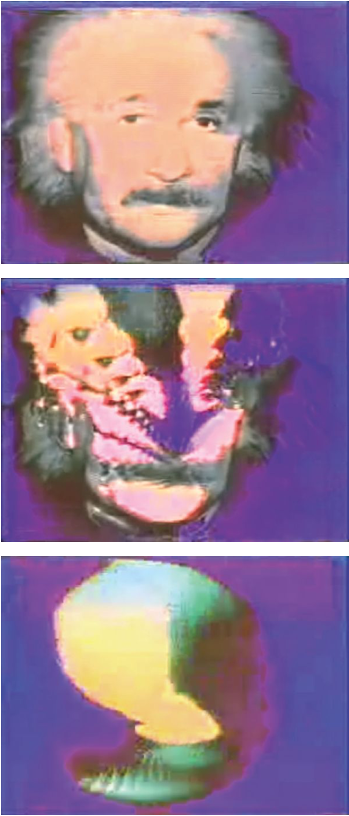
Siegel, Eric: Einstine, video, 1969. (Kane: Algorithms 2014, p.73).
When Lee Harrison III started in 1969 to develop SCANIMATE on the basis of ANIMAC then he chose analog computers (with transistors) and a two-dimensional animation system to transform scanned drawings. Harrison integrated a light table and a camera to capture drawn figures. SCANIMATE made it possible to transform these figures, to present them on a cathode ray tube and to record them with "a monochrome NTSC video camera". ANIMAC´s colour-filters were substituted by "electronic colorizers". The results could be stored on magnetic tape. 28
Harrison III, Lee: SCANIMATE, 1969.
Brand new SCANIMATE
at Dolphin Productions, New York City 1973.
In 1972 Ed Emshwiller built the video "Scape-mates" with SCANIMATE in the TV Lab of the New York station WNET/Thirteen. At the start the image processing was constituted by 24 black and white cells in five different shades of grey. Two cameras of the two computers of SCANIMATE provide the input for the cells. The cells were animated as well as colorized in real time. A computer processed the background and the other one the foreground. Recordings of dancers have been partially edited with "SCANIMATE" before they were included via chromakey procedures in the fore- and the background. 29 Emshwiller utilised the Paik/Abe-Video Synthesizer (see below), too. The video distributor "Electronic Arts Intermix", founded in 1971 by Howard Wise, explains the importance of "Scape-mates" for the development of video films:
With its witty interplay of the `real´ and the `unreal´ in an electronically rendered videospace, and the skilfull manipulation and articulation of sculptural illusion of three-dimensionality, scape-mates introduces a new vocabulary of video image-making. 30
Emshwiller, Ed: Scape-mates, video, 1972.
The central focus of the video tools´ developers is directed to the control of the electron beams´ motion in the cathode ray tube. A bundled electron beam is directed in the vacuum tube between anode and cathode to a screen coated with phosphorous. Electronic impulses constitute an electromagnetic field directing the electron beam. The electron beam is controlled along horizontal and vertical axes, the "xy plotting coordinates". 31 The horizontal and vertical steering between two magnet pairs constitutes either the vector images in oscilloscopes as well as early computer monitors or the raster images in television and later computer monitors (since the midst of the seventies). Raster images are a special form of vector images. For "bitmaps" raster images require memory capacities not available for the early computers.
The manner to provoke the optical effect of motion pictures changes from film to video. Meanwhile the film is constituted by frames for motion phases and these frames are moved mechanically by the projector, the videofilm activates the screen by the writing of the raster image´s "scan lines" with steered electron beams to create the impression of moving images. The possibility to create "transformation images" 32 stored on magnetic tapes becomes the technical basis of experimental videofilms.
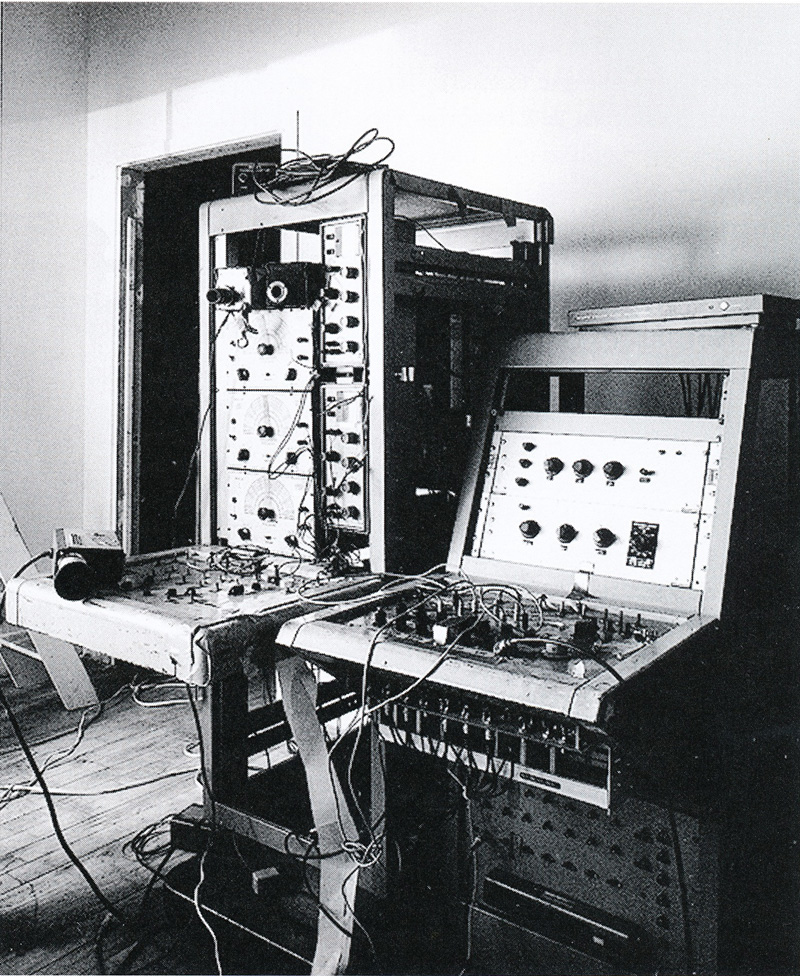
Abe, Shuya/Paik, Nam June: Paik/Abe Video Synthesizer, model of 1972, made for WNET/Thirteen in New York, and photographed in Paik´s studio in 1982 (Courtesy Nam June Paik Studios, Inc. In: Joselit: Feedback 2007, p.47).
The first version of the Paik/Abe video synthesizer from 1970 (see chap. IV.1.1 with ann.11) was not a synthesizer. It could be used to mix and colourize seven external image sources. The colours were invertible and manipulable:
Combining video feedback, magnetic scan modulation and non-linear mixing followed by colorizing, generated its novel style of imagery. 33
External sources (cameras) are used as an input to start signal processes by scan processors like the Paik-Abe synthesizer and the tools by Francois Coupigny, Lee Harrison III (SCANIMATE), Ture Sjölander (presented above), Dan Sandin, Bill Etra and Steve Rutt (presented below). In contrast, Stephen Beck´s "Direct Video Synthesizer" (1970) and Eric Siegel´s "Electronic Video Synthesizer" (1970) generate signals. Both synthesizers can mix these internally generated signals with external camera input.
Siegel, Eric: EVS Video Synthesizer, 1970.
Left: Eric Siegel in the office of Electronic Arts Intermix, New York,
ca. 1971.
Right: function diagram by Jeffrey Schier.
Siegel´s "Electronic Video Synthesizer" used generators and oscillators to process moving patterns. Two mixers conflated the waves of the oscillators and the generators. A third mixer united the input of two cameras. A "color encoder" combined the three to build the "color video signal" 34 Siegel described the possibilities of the "EVS" to process patterns as selectable symmetrical and asymmetrical "geometric formations". Furthermore a video creator could decide if the patterns, the colors or both remain constant or changing. 35 In 1973 Siegel utilised the "EVS" in the performance "Yantra Mantra" at New York´s "The Kitchen". The difficulties to find film documents created with the EVS can be traced back to Siegel´s lack of interest in the production of video documents. Furthermore he prevented Howard Wise in his efforts to produce and to sell the synthesizer. 36
Beck, Stephen: Direct Video Synthesizer, 1970. Left:
top view.
Right: function diagram by Jeffrey Schier.
Stephen Beck´s prototype of the "Direct Video Synthesizer" ("Direct Video #0") included a modified television set with possibilities to control the cathode ray tube´s colour generation. The components for the colour generation were audio signals, oscillators and external analogue mixers. A Buchla synthesizer provided the functions for the colour setting. 37 The Buchla synthesizer was developed for musicians to generate sounds. Beck added to it a further analogue synthesizer with capacities to visualise sounds. But the frequency spectrum of audio synthesizers was not appropriate for interesting visualisations. With a grant from the National Endowment for the Arts (NEA) Beck was able as "artist-in-residence" in the National Center for Experiments in Television (at the station KQED-TV, San Francisco) to solve his problems to visualise sounds and to develop his prototype further. The modules for form, motion, texture and colours of the "Direct Video #1" could be controlled via voltage regulators in real time, for example in live performances. 38
Beck, Stephen/Jepson, Warner: Illuminated Music 2 & 3, video documentation of a PBS broadcast (Public Broadcasting Service), 1973. Left: Beck at the Direct Video Synthesizer. Right: Beck´s visualisation of Jepson´s music.
In "Illuminated Music 1", a live broadcast of the station KQED-TV (San Francisco) at 19th Mai 1972, Beck visualised Yusef Lateef´s improvisations on "Like It Is". In 1973 the National Center for Experiments in Television recorded "Illuminated Music 2 & 3" for a broadcast of the PBS/Public Broadcasting Service, Arlington/Virginia. The recordings show Warner Jepson at the Buchla Synthesizer in a live performance with Stephen Beck at the "Direct Video Synthesizer". Meanwhile Beck controlled the output on a little cathode ray tube, the public could follow the visualisations of Jepson´s music on big screens. 39 Coloured areas with wave-like contours overlapping and concealing other planes, wave-like moving particles and continuous as well as broken waved lines dominated the visualisation of a music accelerating and slowing down the tone sequences like ascending and descending waves. Several times the visualisation reacted only after a number of sound waves with perceptible changes of the visual patterns.
Sandin, Dan: 5 Minute Romp Through the IP [Analog Image Processor], video, 1973.
Dan Sandin presents the technical basis of his "Analog Image Processor" (1971-73) as a "general purpose analogcomputer" being programmable via "patch cables". Sandin has "optimized" the analog computer "for processing video information...[and] television information". 40 The "processing modules" can be activated via "patch cables". With these modules image sequences from an external source can be transformed by the manipulation of controllers: "The instrument is programmed by routing the image through various processing modules and then out to a monitor or video tape recorder." 41 Between "processing modules" and the output for the monitor the "output color encoder" adds colours. 42
In 1973 Sandin demonstrates in the video "Triangle in Front of Square in Front of Circle in Front of Triangle" that the signal processes in the cathode ray tube being controlled with his video tool contradict the concept of perspectival image space:
A demonstration of the fact that thinking of video keying as putting one thing in front of another is inaccurate and limiting. The Analog Image Processor was programmed to implement the logic equations if triangle and square show triangle, if square and circle show square, if triangle and circle show circle. 43
Sandin, Dan: Triangle in Front of Square in Front of Circle in Front of Triangle, video, 1973.
Meanwhile Steina and Woody Vasulka used a "George Brown Multi-Level Keyer" (1973) to provoke the impression of three-dimensionality by the layering of levels (cf. "Golden Voyage", 1973), Sandin tried to proove that the result is not an adequate design for the cathode ray tube. 44 The vocabulary of the video technology should – as Sandin demanded – supersede the perspectival image space.
In 1973 Tom DeFanti developed GRASS (Graphics Symbiosis System) for the digital minicomputer PDP 11/45 of the Digital Equipment Corporation (DEC, since 1972). 45 It was possible to build two-dimensional elements as vectorial animation in black and white by typing instructions on a keyboard and to control the result in real time on the cathode ray tube. David Sturman characterises the possibilities of GRASS: "With GRASS, people could script scaling, translation, rotation and color changes of 2D objects over time." 46 At the University of Illinois in Chicago the colour animation could be realised with a "Sandin Analog Processor" (see above): The digital animation was followed by an analogue animation.
DeFanti, Tom/Morton, Phil/Sandin, Dan/Snyders, Bob: Ryral, video of a live performance at the University of Illinois, Chicago 1976.
In 1976 Dan Sandin and Tom DeFanti presented their video animation system in "Ryral", a computer performance with music and animations processed in real time at the second "Electronic Visualization Event" organized at the University of Illinois in Chicago: Bob Snyder´s music processed by an "analog EMU Synthesizer" was to hear simultaneously. The dancers oscillating in Emshwiller´s "Scape-mates" (see above) between fore- and background recur in "Ryral" changed into an actrice sometimes recognizable as a silhouette: Camera recordings of a dance performance are transformed in a two-dimensional image processing creating perceptual tensions by contours and colours especially in cases if the planes merged together. These tensions provoke difficulties to sort out the levels between fore- and background. In some colour constellations patterns with circles and spirals in moving dotted lines provoke flickering effects. 47
Richard Monkhouse designed and built the first Spectron Video Synthesizer (named Spectre) for Electronic Music Studios, Ltd (EMS) London, in 1974. The same "pin-matrix patch board" 48 was used for the EMS Spectron as was the case for the company´s VCS 3 Audio Synthesizer (1969, and its later developed audio synthesizers), but the board was expanded to accommodate the video structures required. There are two main patchboards: the "Digital Signal Matrix" (DSM), and the "Analog Control Matrix" (ACM). The analog synthesizer EMS Spectron worked with digital video signals since, according to Richard Monkhouse, digital signal processing prevented the inevitable crosstalk associated with video frequencies.49
Electronic Music Studios, Ltd (EMS): Spectron, 1974.
Video synthesizer
(Siedler: EMS undated, p.7).
The video synthesizer could produce its own shapes and colours, or could be used to modify the colours of an external video input signal. An existing video signal could be colourised or patternised, then it could be combined with a moving or static electronically-generated image. Audio signals could also be used to dynamically change image attributes in real-time.
Two identical "shape generators" included 16 basic forms. These forms were "derivatives of a circle and segments of a circle with logic or modulation effects applied" and were changeable by the analog voltage control (see below). The basic forms could be selected manually or by automatic cycling selection. In the last case the synthesizer replaced the basic forms "at a pre-determined rate". 50 Beside these internal image sources an input from external image sources (video camera) was possible, and it could be processed as well. The images of this input could be superimposed by static or moving forms and patterns containing elements generated from internal sources (basic forms).
The "X" and "Y" counters of the digital patchboard (DSM) were used to produce static images with horizontal ("X") and vertical ("Y") stripes in binary width multiples. "Slow counters" provided six binary-related square waves – used for state change to import flash and movement effects.
The edges of a form were modifiable with the "edge generator" and "echo oscillations" were producable with the "delay"-function. To change the distances between `echoes´ "flip flops" were usable because they were able to "halve the horizontal spacial frequency of any form patched into them".
Electronic Music Studios, Ltd (EMS): Spectron, 1974.
Video synthesizer.
Left: Digital Signal Matrix and Analog Control Matrix
(Monkhouse: Art 1974, p.26).
Right: 16 basic forms (Siedler: Spectre undated).
The "video comparator" was used to divide the grey scale of a black-and-white camera input signal into seven areas. The spacing of the input´s grey tones could include all ("maximum") or only the lowest values ("minimum"). Seven "output rows" corresponded to the seven grey levels. Each of these "output rows" was modifiable via the "Digital Signal Matrix" (colour, colour tone, luminance). To each "output row" patterns could be added in using the patchboard´s function "overlay gates". Via "overlay gates" it was possible to produce "layers of moving patterns". 51
The "Digital Signal Matrix" enabled artists to combine the basic forms with regards to the logical criteria conjunction ("AND"), disjunction ("OR") and exclusive disjunction ("XOR"). 52 The voltage of the output signals was controllable via the "Analog Control Matrix". This "matrix" made it possible to control "four separate shape outputs" (luminance, colour, movement, size etc). Each of the two "shape generators" supplied two "shape outputs". Further modifications of the video output were the two oscillators for "sine or square wave outputs". Random voltages could be used, as well as audio signals. Using the separate A and B outputs, these outputs could also be combined for varied logical combinations.
If it was planned to use a background pattern in further film sequences then it could be transferred with the "inverters" into the foremost layer and transformed further. 53
Guyonnet, Jacques: Lucifer Photophore, video, 1975.
Jacques Guyonnet´s «Lucifer Photophore» (1975) presents sometimes only the borders (like fluctuating edges – noise effect) of its leitmotif – a repeating, mostly red oval. It appears several times as being a part of and constituted by variations of the Spectron´s basic forms developed themselves as circles blended into one another.
One of the best examples of the potential of the EMS Spectron is illustrated in the work «Labyrinthe Fluides» by Geneviève Calame and Jacques Guyonnet (1976). One of the mysteries of the counter logic combinations is the "maze patch" in the background of «Labyrinthe Fluides». The "digital adder" technique is used here with the X and Y counters in a particular combination that has not been explained. All that is known is that many, if not all, logic combinations of a set of binary bits can be made by asymmetric functions such as AND and OR, and inversion/symmetrical controlled inversion such as XOR. Sets of pins in the same column in the DSM patchboard do a wired OR function. If one uses the OR on a series of X counter outputs, one gets thin vertical lines. If one then applies XOR to the invert input of each X counter bit, one effectively makes a sort of digital adder, turning the vertical lines into diagonal lines. With variations modes of experimentation, "many kinds of linear, diamond, maze and 'fractal'- like patterns" can be produced.
The directions and tempi of the "maze patch´s" animation are often presented in a manner derived from the modifications of the forms in the foreground. Video feedback is used here to merge forms from the background into the foreground, so that enlarged versions of shape and texture interpenetrate each other – producing many fluid and organic developments and moiré texture "weaves" of modulated line interactions. If abstract forms in the foreground are dissolved into organic patterns then visual interferences with deformations of the "maze patch" in the background can arise. Sometimes the "maze patch" overlaps or interpenetrates abstract forms. 54
Calame, Geneviève/Guyonnet, Jacques: Labyrinthes fluides, video, 1976.
From 1977 to 1980 Warren Burt, Robert Cahen, Richard Monkhouse and Plastic Bertrand (Roger Jouret, in a music video) used the EMS Spectron to produce video art. 55
Etra, Bill/Rutt, Steve: Rutt/Etra Scan Processor, 1973.
Left: Rutt/Etra Model RE-4 Scan Processor.
Right: function diagram by Jeffrey Schier.
Etra, Bill/Rutt, Steve: user manual for the Rutt/Etra
Scan Processor with "system information flow".
(Rutt/Etra: RE Video Synthesizer Systems Models RE 4A and RE 4B 1974,
p.3).
In 1973 Steve Rutt, Bill and Louise Etra developed a "scan processor" that was utilised in video productions by Nam June Paik, Steina and Woody Vasulka as well as Gary Hill. 56 With the "Rutt/Etra Scan Processor" signals of a black-and-white monitor can be modified. The signals are modified by controlling the voltage along the horizontal and vertical axes. It is possible to locate the images of a video input on different places of an image raster. Furthermore the dates of the image portions´ screen presentations are modifiable – Bill Etra:
The Rutt/Etra changes the time in which you see parts of the picture. It is a machine that manipulates images in time. 57
Etra, Bill /Rutt, Steve: Rutt/Etra Scan Processor, 1973. Demo by Bill Etra, video.
Since 1975 the scan processor was distributed commercially with waveform generators, four-quadrant multipliers and a summing amplifier. Optionally it could include a ramp generator for the processing of many motions. Seizes, localisations, zoom and intensity could be adjusted on 15 turning knobs. The monitor was integrated into the scan processor and presented the transformed images. Deflection yokes were mounted around the monitor. The "sine, triangle, or square waves" processed by deflections appeared on the monitor whose images were recorded by a camera, colorised and led to a videotape recorder of a broadcast system. 58
Vasulka, Woody: C-Trend, video, 1974.
In the "Vasulka effect" (see below) the brightness of the video input determines the positioning on the vertical axis. Zones becoming brighter and darker move up and down: "When combined with other synthetic waveforms, the raster forms a three dimensional contour map where video brightness determines elevation." 59
Woody Vasulka transforms in "C-Trend" (1974) driving cars into disturbed sinus waves. Street scenes were recorded with a camera placed in a window. The recordings are "scanned again" and are "modulated" in the "Rutt/Etra Scan Processor" via "retiming and repositioning" with "deflections" whilst the sound is reproduced unchanged. 60 The staggered wave lines facilitate observers to structure them visually in a spatial manner as the layers are successively arranged behind each other: Disturbances in multiple layers appearing simultaneously or following in short distances one after another provoke the impression of moving bodies. Because the recorded driving cars are not easily recognisable, an "intermediate sphere" ("Zwischenreich") appears situating the recognition of moving objects between still recognisable recordings and already constructed images. When the black background is substituted by "video `noise´", then it is "created by blackout intervals which normally fill the `gap´ between the scanning of singular fields." 61
Vasulka, Woody: Artifacts, video, 1980.
Woody and Steina Vasulka bought a minicomputer DEC LSI-11 (since 1975), a version of the PDP-11 (PDP-11/03). When their student Jeffrey Schier developed concepts, how to use the minicomputer in video image processing, he initiated the construction of the "Digital Image Articulator" (1976-77). 62 The result of the programming can be seen and corrected without a recognisable time delay. The "Digital Image Articulator" processes images by combining rectangular basic elements: The partition into discrete basic components substitutes the waveforms of the "Rutt/Etra Scan Processor". Woody Vasulka constructs in "The Arithmetic Logic Unit (ALU)" the relations between discrete elements "A" and "B" in following the Boolean algebra. 63 The new structure creates "unusual patterns of color and box-like textures without equivalence in analog video". 64 In 1980 Woody Vasulka demonstrates that in "Artifacts": The structure is relatively rough and appears today again relatively uncommon. The creation of super-signs and textures with microstructures built by rectangles alternately attract the observer´s attention. An optical flicker constituted by discrete elements forms recognisable formations again and again in the course of the film. 65
Vasulka, Woody. Left: Didactic Video, Tableau IV, 1975
(Vasulka/Nygren: Video 1975, p.13), demonstration of the Rutt/Etra Scan
Processor.
Right: Syntax of Binary Images, Tableau 3 & 4, 1978 (Vasulka/Weibel:
Buffalo 2008, p.423), demonstration of the relations between the discrete
elements "A" and "B" in "The Arithmetic Logic
Unit (ALU)".
In "Artifacts" Woody Vasulka demonstrates the differences between the analogue image processing of the "Rutt/Etra Scan Processor" and the digital image processing of the "Digital Image Articulator" by picking up a hand as subject again that he used earlier to demonstrate the video vocabulary made possible by the "Rutt/Etra Scan Processor": "Tableau IV" of his text "Didactic Video" (1975) presented four transformation phases of a hand. The hands appeared in concave and convexe reliefs built by the waveforms in inclined planes constituted by staggered horizontal lines. In contrary, a hand is presented in "Artifacts" on a sphere whose outline is multiplicated meanwhile the surface of the hand is dissipated into optical flicker. In a comparison with an earlier video it becomes easier to recognise that the flicker elements in "Artifacts" are rectangles and not flickering signals as in "Noisefields" that was realised in 1974 with analogue video tools: In both videos a circle is raised from the ground and then again merged with it, but in "Noisefields" the circular outline given by the video input remains preserved also and especially in positive-negative inversions, meanwhile in "Artifacts" the circle forms can be recognised sharper or weaker because their outlines are constituted and dissipated by combinations of rectangles. "Electronic Snow" is in "Noisefields" the basis of audio noise as well as of visual flickering. 66
Vasulka, Woody: Noisefields, video, 1974.
In "Artifacts" the digital processing is presented in real time, without the acceleration of the images in film sequences as it is usual in computer animation. Vasulka points "in a spirit of exploration" (voiceover at the start of the video) the oberservers´ attention to the new functions to build and to transform images. The video includes varying modes of presentation close to pointillism, cubism and surrealism, meanwhile the sound underscores the unitary technical basis of the signal processes of all kinds of image and audio processing. Vasulka explains at the beginning of the video:
By artifacts I mean that I have to share the creative process with the machine. It is responsible for too many other elements in this work.
For the distribution of video synthesizers and processors their authors didn´t only choose the usual ways of sale:
In the seventies Dan Sandin and Phil Morton augmented the "Analog Image Processor" to an open developers´ platform called "Distribution Religion". The construction plans of the "Sandin Analogue Image Processor" were available (by paying the expenses for copies) for reconstructions and further developments by constructors and users were welcome. These developments could be integrated into the plans. The plans of the "Sandin Analogue Image Processor" and Phil Morton´s videos were distributed with Morton´s licence "Copy-It-Right" inviting the production and distribution of copies. 67
After Seth Siegelaub´s contract published in the catalogue of the documenta 5 (Kassel, 1972) expanded the artists´ exploitation rights and obliged the owners of works to share future income with their creators 68, Dan Sandin and Phil Morton choose the opposite strategy by eliminating the restrictions that have been installed via copyright and the contracts for the distribution and further developments.
Dan Sandin´s practice to disseminate the construction plans of his "Analog Image Processor" and the commercial distribution of the Rutt/Etra Scan Processor are counter-models. This opposition continues to determine the discussions on copyrights until today. Sandin wrote:
The Image Processor may be copied by individuals and not-for-profit institutions without charge, for-profit institutions will have to negotiate for permission to copy.
Nowadays the alternative propositions to use copyrights published by Creative Commons offer authors ways to announce how they differentiate between releases of restrictions for non-commercial users and restrictions for commercial users of their files. Permissions for non-commercial multiplications and distributions can be announced via links to the relevant propositions of the site "Creative Commons". Then the determination of the amount of fees for commercial distributions remains a task of negotiations with the author. 69
The video practice of the activists and the experimental filmmakers continues the development of alternatives to the role play in movies. This development was driven by the experimental filmmakers of the fifties and sixties in frame-by-frame animation procedures. The camera as a reproducing technology and image creating procedures constitute the opposite ends of a scale. In the sixties these both ends of the scale of experimental filmmaking can be found in films realised by people of Andy Warhol´s factory ("Sleep", 1963 and others) on one side and on the other side in structural films by Peter Kubelka ("Arnulf Rainer", 1958-60), Tony Conrad ("The Flicker", 1966) or Paul Sharits ("Ray Gun Virus", 1966). 70 The camera fixated at a static place in Warhol´s Factory is substituted in the seventies by the mobile video equipment of activists and the self-presentation of actresses or actors in front of the camera is transformed into a critical self-embedding of the filmmaking and filmed persons into their social context. Warhol´s negation of a director-dependent language is substituted by renewed forms of film documentations and TV news. The cutting procedures for the combination of frames in structural films substitute the authors of experimental videos by tools directing the motions of electron beams in the cathode ray tube. This causes in "Noise Fields" a change in the function and meaning of the "flickers" being produced in structural films by the thematisation of film as material via filmcuts and the combination of frames. The criticism of the cinematic film language by non-narrative film forms is augmented by the video practices to a television criticism (see chap. IV.1.1). "Commercial broadcast" appears reduced in forms and contents if it is compared to the explored possibilities of video technology.
On the one hand the constructors of video tools developed new means of production and partially they demonstrated themselves the possibilities to develop a video-specific film language. On the other hand the video activists used the video camera as a means to create critical statements and broadcasted the documents produced by the persons living under the criticised conditions or sent copies on videocassettes. On the experimental side the signal processes were central, on the activist side the mobile camera. The experiments with the new medium resulted in new means of production and new methods to distribute these means ("Distribution Religion", see above), meanwhile the media activists thematised the contemporary social conditions by utilising available means of production and the distribution of the results (Community TV, see chap. IV.1.1) in uncommon ways.
Dr. Thomas Dreher
Schwanthalerstr. 158
D-80339 München
Germany.
Homepage with numerous articles
on art history since the sixties, a. o. on Concept Art and Intermedia
Art.
Copyright © (as defined in Creative
Commons Attribution-NoDerivs-NonCommercial 1.0) by the author, January
and April 2012, June 2014, August 2015 (German version)/October 2013 and
June 2014/August 2015 (English translation).
This work may be copied in noncommercial contexts if proper credit is
given to the author and IASL online.
For other permission, please contact IASL
online.
Do you want to send us your opinion or a tip? Then send us an e-mail.
Annotations
1 Russett/Starr: Animation 1988, p.32-177. back
2 Dunn/Vasulka/Weibel: Eigenwelt 1992; Miller Hocking: Principles 1978; Russett/Starr: Animation 1988, p.178-210; Spielmann: Video 2008, p.46-57,89-112. back
3 Dunn/Vasulka/Weibel: Eigenwelt 1992, p.96-103. back
4 Sony CV/VCK 2000, since 1965: without author: Sony CV 2000 (undated); without author: Sony CV Series Video (undated); Sherman: Birth 2007. back
5 On the Sony Porta Pak video equipment and its different
meanings for activists as well as experimental filmmakers: Vasulka: Sony
CV Portapack 1992.
Sony CV 2400 Porta Pak, since 1968: without author: Sony DVK-2400/VCK
2400 (undated); Miller Hocking: Texts 1992.
Sony Porta Pak AV 3400, since 1969/70: Bensinger: Video 1981, p.157ss.,161,164,166s.,172,174;
without author: SONY AV-3400 PORTA PAK (undated). back
6 Murphy: Television 1997, chapter "Local Television News Archives": "In the mid-1970's, a period marked by the transition from 16mm news film to 3/4-inch U-matic cassettes, about 700 commercial television stations were operating in the United States. Less than 10% of the stations transferred their news film to public archives. The rest was mostly destroyed." back
7 without author: Program Guide 1972, unpaginated: "In issue one, volume one of Radical Software (Summer, 1970) we introduced the hypothesis that people must assert control over the information tools and processes that shape their lives in order to free themselves from the mass manipulation perpetrated by commercial media in this country and state controlled television abroad. By accessing low cost 1/2" portable videotape equipment to produce or create or partake in the information gathering process, we suggested that people would contribute greatly to restructuring their own information environments: YOU ARE THE INFORMATION...Through such decentralization of the information medium, we asserted that the overall information environment of this country could be humanized and revitalized." back
8 Stoney, George: First Transmission of ACTV, Video, b/w, sound, 8 min., 1972. back
9 Video, 4 min. 23 sec., b/w, sound, in: Nadeau: Medium 2006, p.53,57-62; Youngblood: Cinema 1970, p.343s. back
10 Barzyk, Fred: The
Medium is the Medium, WGBH-TV, Boston, 3/23/1969: Nadeau: Medium 2006,
p.34-72.
Paik, Nam June: Electronic Opera #1, WGBH-TV, Boston, 3/23/1969: Decker:
Paik 1988, p.150,152,193,200, ill.99; Fifield: Paik/Abe Synthesizer 2000;
Joselit: Feedback 2007, p.48s.; Nadeau: Medium 2006, p.64-67; Youngblood:
Cinema 1970, p.306. back
11 Paik/Abe Synthesizer at the WGBH-TV, Boston: Decker:
Paik 1988, p.151; High: Mods 2014, p.367. Previously the broadcast WNET
(Channel 13 in New York City) is said to have bought a prototype (without
author: Paik-Abe Video Synthesizer (undated)).
Paik, Nam June/Atwood, David: Video Commune – The Beatles from Beginning
to End, WGBH-TV. Video, 8 min. 36 sec., colour, silent, 1970 (film documentation:
Yud Yalkut, 1972-92): Decker: Paik 1988, p.152; Fifield: Paik/Abe Synthesizer
2000. back
12 VanDerBeek, Stan: Violence Sonata, WGBH-TV, Boston,
1/12/1970: Davis: Art 1973, p.90; without author: Vanderbeek (undated);
O´Grady: Vanderbeek 1970.
Knowlton, Kenneth/VanDerBeek, Stan: Poem Fields, 1964, in: Auzenne: Visualization
1994, p.29s.,45; Youngblood: Cinema 1970, p.246-249; see chap. IV.2.1.2.
More experiments with participation TV:
Davis, Douglas: Electronic Hokkadim, WTOP-TV, Washington D.C., 6/12/1971.
In: Ross: Davis 1972, unpaginated; Deecke: Davis 1978, p.7.
Davis, Douglas: Talk Out: A Telethon, WCNY-TV, Syracuse/New York, 12/1/1972.
In: Davis: Talk Out 1973; Deecke: Davis 1978, p.6ss.,17,96; Torcelli:
Video 1996, p.24. back
13 Paik: untitled 1971. back
14 Gigliotti: History 2003; Joselit: Feedback 2007, p.93-99. back
15 "Consciousness industry"/"Bewußtseins-Industrie":
Enzensberger: Aporien 1962/1980, p.60,68,73; Enzensberger: Baukasten 1970/1997,
p.97-101,106s.
"Participatory democracy": Hill: Attention 1996, p.2 with ann.8
(with reference to: Students for a Democratic Society (SDS): Port Huron
Statement, 1962). back
16 as, f.e., in "ANIMAC" (1959/60), "SCANIMATE"
(1969) and the "Rutt/Etra Scan Processor" (1973, see below).
Furthermore in "video feedback" the result presented on the
monitor of a video synthesizer equipment is recorded with a camera. These
recordings are led back to the video synthesizer for further processings.
(Jones: Synthetics 2011, p.205ss.) back
17 Bute: Abstronics 1954 (quotations).
Naumann: Sound 2009, p.48: Ralph K. Potter "designed a custom-built
device through whose buttons and switches she could influence the emerging
Lissajous curves, changing their position, speed, and brilliance, as well
as creating an impression of three-dimensionality." Cf. Betancourt:
History 2013, p.88s.; Kane: Algorithms 2014, p.132; Naumann: Sound 2009,
p.48ff.; 279f.; Zinman: Circuit 2012, p.140s. Oscillographs were used
in productions of film animations by Hy Hirsh ("Divertissement Rococo",
1951; "Eneri", 1953; Come
Closer, 1953. Lit.: Betancourt: History 2013, p.140) and Norman McLaren
(Around Is Around,
1951, with Evelyn Lambart; Naumann: Sound 2009, p.279). For the first
half of the fifties the author knows no other use of custom-built oscillographs
in productions of animations than the one by Mary Ellen Bute. back
18 Franke: Grafik 2014 (quote); conversation with Herbert
W. Franke, 8/13/2014 in Puppling nearby Egling/Bavaria, and e-mails, 8/17/2015
and 8/21/2015 (quotes).
Oscillograph: constructed by Siemens (and called "Vorführgerät"/"demonstration
device") with a sharpening screen, diameter between 10 and 12 centimeter.
Among others the oscillograph made by Siemens was used for the "presentation"
of "alternate current". The sharpening screen enabled Franke
to place lines "so near to each other" causing the effect to
receive "light-dark transitions". These transitions were not
possible with the oscillograph used before (see chap. III.2.1) because
of its "thick drawn lines" (Franke, e-Mail 8/17/2015). back
19 «Luminoscope I», 1959. In: Cassou/Habasque/Ménétrier:
Schöffer 1963, p.86 (quotations).
Variations
luminodynamiques 1, 1961. Film,
16mm, b/w, sound. Collection Centre Pompidou, Paris. In: Cassou/Habasque/Ménétrier:
Schöffer 1963, p.86-89. Thanks to Jean-Noel Montagné for directing
my attention to Schöffer´s videographic experiments. back
20 According to Jeffrey Schier the "ANIMAC was developed in the early 1960´s" (Schier: Scan Processors 1992, p.94), but Walter Funk mentions the turn of the year 1959/60 (see above) as the date, when the "first version" was realised, but he does not indicate any document as proof (Funk: Animac 2010, p.53). Further Lit.: Funk: Animac 2010, p.53s.,58 (quotations); Harrison: We 1992; Schier: Scan Processors 1992, p.93ss.; Smith: Computers 1974, p.149; Youngblood: Cinema 1970, p.200. back
21 See the manipulations of television sets, esp.
cathode ray tubes, by Nam June Paik (television set with distorted images
on monitors in the exhibition "Exposition of Music – Electronic
Television", Gallery Parnass, Wuppertal, March 1963; Magnet
TV, 1965) and Wolf Vostell (television set with distorted images on
monitors in the exhibition "TV Decollage", Smolin Gallery, New
York, Mai 1963; Sun
in Your Head, Film, 1963).
In the early sixties Stan Ostoja-Kotkowski manipulated a television set
for the first time, and in 1962 he found an engineer (Malcolm Kay?) at
the Philips Research Laboratories in Hendon/South Australia constructing
a device with oscillators for his needs to control the electron beams
in the cathode ray tube of a television set. In July 1964 Ostoja-Kotkowski
exhibited the "electronic drawings" realised with this device
for the first time at the Argus Gallery in Melbourne (Jones: Synthetics
2011, p.126-129,131s. with fig.5.8ss.; Meigh-Andrews: History 2014, p.10s.,14).
back
22 Meigh-Andrews: History 2014, p.135; Zinman: Circuit 2012, p.146s. back
23 Meigh-Andrews: History 2014, p.135,209-212; Youngblood: Cinema 1970, p.331-334; Zinman: Circuit 2012, p.147. back
24 Robert Cahun 2005. In: Meigh-Andrews: History 2014, p.138. back
25 Meigh-Andrews: History 2014, p.137f. Furthermore, Meigh-Andrews mentions Dominique Belloir, Olivier Debré and Piotr Kamler as artists having used the «Truqueur Universel» to create videos. Other artists: Jean-Paul Cassagnac, Peter Foldes, Martial Raysse (Langlois: Schaeffer 2010). back
26 Youngblood: Cinema 1970, p.314ss. Meigh-Andrews: History 2014, p.138s.; Kane: Algorithms 2014, p.71-74. back
27 Hill: Siegel 1996. back
28 Betancourt: History 2013, p.167ss.; Funk: Animac 2010, p.53s.,58 (quotations); Harrison: We 1992; Youngblood: Cinema 1970, p.200; Schier: Scan Processors 1992; Smith: Computers 1974, p.149,151s. back
29 Scape-Mates: 28 min. 16 sec., colour, sound, in:
Russett: Robert: Interview Ed Emshwiller (1974). In: Russett/Starr: Animation
1988, p.207; Spielmann: Video 2008, p.92.
In chroma keying
an image layer with only one colour range is substituted by a filmed overlay.
Objects which move before the image layer for chroma keying remain unchanged.
Television presenters can walk before a film projection substituting a
studio wall painted blue for chroma keying. back
30 without author: Scape-mates (undated). back
31 Youngblood: Cinema 1970, p.194: "...at a rate of 100,000 per second within a field of 16.000 possible xy coordinates". back
32 "Transformation image"/"Transformationsbild":
Spielmann: Video 2008, p.4s.
On the cathode ray tube as a display for vector and raster images: Johnson:
Synthetics 2011, p.40,43s.
Magnetic tape, first video cassettes: Sony
U-matic, since 1971. In: Bensinger: Video 1981, p.131-145. back
33 Schier: Paik-Abe Video Synthesizer 1992. Cf. Betancourt: History 2013, p.163-167; Decker: Paik 1988, p.150s.; Furlong: Notes [1] 1983, p.36 with ann.13; High: Mods 2014, p.365ss.; Joselit: Feedback 2007. p.47-50; Spielmann: Artists 2014, p.518s.; Spielmann: Video 2008, p.98ss. back
34 Schier: Eric Siegel EVS Synthesizer 1992. back
35 Yalkut: Electronic Video Synthesizer 1977/78. Cf. Dolanova/Vasulka: Vasulka 2014, p.286. back
36 Furlong: Notes [1] 1983, p.36; Sturken: TV 1984, p.8. back
37 Buchla Synthesizer: Buchla 100 Series, 1964, in: Dunn/Vasulka/Weibel: Eigenwelt 1992, p.96-99. back
38 Description of the modules, in: Schier: Direct Video Synthesizer 1992, p.124s. back
39 Beck: Beck Direct Video Synthesizer 2000; Beck: Music (undated); Beck: Video (undated); Furlong: Notes [1] 1983, p.37. Beck and Jepson used video projectors of the type "Eidophor GE Light Valve" in performances of "Illuminated Music 2 & 3". back
40 Dan Sandin in "5 Minutes Romp thru the IP", 1973, video, b/w, sound, 3 min. 52 sec. In: URL: http://www.youtube.com/ watch?v=8qh6jRzjmcY (12/17/2011). back
41 Dan Sandin, in: Morton, Phil/Sandin, Dan/Wiseman, Jim: In Consecration of a New Space. A Color Video Process. Information sheet, 1/26/1973. Cited from: Spielmann: Video 2008, p.99s. with ann.69. back
42 Schier: Image Processor 1992. Cf. Miller Hocking: Grammar 2014, p.461; Spielmann: Artists 2014, p.507s. back
43 Dan Sandin 2004. In: Spielmann: Video 2008, p.99s. with ann.69. Cf. Dolanova/Vasulka: Vasulka 2014, p.289s. back
44 Brown, George: Multikeyer, 1973. In: Dolanova/Vasulka: Vasulka 2014, p.288; Schier: Multi-Level-Keyer 1992; Spielmann: Video 2008, p.103s., 200. back
45 Magnenat-Thalmann/Thalmann: Computer Animation 1990, p.31,33. back
46 Sturman: State 1998. back
47 Cates: Ryral 2009. back
48 Siedler: Spectre undated. back
49 Monkhouse: Art 1974, p.22: "Signals on this patchboard are carried in digital form because crosstalk problems at video frequencies make an analog patchboard well nigh impossible." back
50 Siedler: EMS undated. back
51 Monkhouse: Art 1974, p.22ss. back
52 EMS: User undated. back
53 EMS: User undated; Monkhouse: Art 1974, p.23,26 (quotes); Siedler: EMS undated (quotes); Siedler: Spectre undated (quotes); Jeffrey Siedler, e-mail, 8/25/2015 (quotes). back
54 Siedler: Secrets undated; Jeffrey Siedler, e-mails, 8/18/2015 and 8/25/2015 (quotes). back
55 Warren Burt: Five Moods (3x4x) (for Ned Sublette), 1979; Return to Uranus (after Ruggles) Veils 2, 1979; Watermusic Dazzler (after Monk), 1979, Georgeous Formalisms (Even 5 More Moods, Yet), 1979. Robert Cahen: Sans titre, 1977; L´Eclipse, 1979; Trompe l´oeil, 1979; L´ent´apercu, 1980. Richard Monkhouse: Shine on You Crazy Diamond, 1977; Transform, 1978. Plastic Bertrand: Ca plane pour moi, 1978 (Meigh-Andrews: Donebauer 2007, S.464; Meigh-Andrews: History 2014, S.158f. I would like to thank Jeffrey Siedler for informations about artists using the "EMS Spectron", for the mailing of documents and for corrections). back
56 The "Rutt/Etra Scan Processor":
– in Nam June Paik´s Videos: Spielmann: Video 2008, p.154s.
(on "Global
Groove", 1973); Spielmann: Video 2009, chap.4.
– in Steina and Woody Vasulka´s Videos: Spielmann: Video 2009,
chap.4;
Hatanaka/Koizumi/Sekiguchi: Vasulka 1998, p.14ss.,21,34,42,46,48; see
below.
– in Gary Hill´s Videos: Broeker: Hill 2002, p.96-99; Furlong:
Manner 1983, p.13 (on "Videograms",
1980-81, and "Happenstance
(part one of many parts)", 1983); Spielmann: Video 2008, p.108s.;
Spielmann: Video 2009, chap.4.
back
57 Cited in Miller Hocking: Rutt/Etra 1986. back
58 Miller Hocking: Grammar 2014, p. 458,460; Miller Hocking: Rutt/Etra 1986; Rutt: What 1992; Rutt/Etra: RE Video Synthesizer Systems Models RE 4A and RE 4B 1974; Schier: Rutt/Etra 1992; Spielmann: Artists 2014, p.519ss.; Vasulka/Nygren: Video 1975, p.9. back
59 Schier: Rutt/Etra Scan Processor 1992, p.139. Cf. Spielmann: Video 2008, p.205. back
60 Spielmann: Video 2008, p.204s. back
61 Dolanova/Vasulka: Vasulka 2014, p.291. Cf. Meigh-Andrews:
History 2014, p.152.
"Zwischenreich": Klee: Denken 1964, p.91s.,313. back
62 In 1980 Steina Vasulka documented the development of the "Digital Image Articulator" in the video "Cantaloup", in: Hatanaka/Koizumi/Sekiguchi: Vasulka 1998, p.20; Vasulka/Weibel: Buffalo 2008, p.496s. back
63 Vasulka/Hagen: Syntax 1978. back
64 Schier: Digital Image Processor 1992, p.145. back
65 Furlong: Notes [2] 1983, p.16; Spielmann: Artists
2014, p.516s.; Spielmann: Video 2008, p.207s.; Vasulka/Weibel: Buffalo
2008, p.448s.,452s.
In 1979 the video "Bad"
presents an utilisation of the "Digital Image Articulator",
that was done before "Artifacts" was realised: Spielmann: Video
2008, p.208s. with ill.104; Vasulka/Weibel: Buffalo 2008, p.496s. back
66 "Didactic Video", "Tableau IV":
Vasulka/Nygren: Video 1975, p.13.
On the digitalisation in "Artifacts": Dolanova/Vasulka: Vasulka
2014, p.296ss.; Spielmann; Video 2008, p.207s. with ill.121s.; Spielmann:
Woody Vasulka 2004; Sturken: Artifacts 1996; Vasulka/Weibel: Buffalo 2008,
p.461.
"Noisefields": Dolanova/Vasulka: Vasulka 2014, p.288; Spielmann:
Video 2008, p.203s.; Spielmann: Video 2009, chap.4.
back
67 Cates: Copying-It-Right 2008; Cates: Copying-It-Right 2014; Furlong: Notes [1] 1983, p.38; Sandin: Distribution Religion 1992; Sandin/Morton: Distribution Religion 2014; Schier: Image Processor 1992, p.134. back
68 Siegelaub: Artist´s Reserved Rights Transfer and Sales Agreement 1972. back
69 Sandin: Distribution Religion 1992 (quote); Sandin/Morton: Distribution Religion 2014. Cf. the choice of licenses offered by Creative Commons, in: URL: http://creativecommons.org/choose/ (12/22/2011). back
70 Hein: Film 1971, p.103,106; Hein: Structural Film 1979, p.96s.; Sitney: Film 1974, p.409ss.,424s.; Vasulka/Weibel: Buffalo 2008, p.315s.,542s. back
[ Table of Contents | Bibliography | Next Chapter ]
[ Top | Index NetArt | NetArt Theory | Home ]
